










Monastery Chilandar
on Holy Mountain of Athos
in this, 1998 year the Chilandar Monastery celebrates its 800th Anniversary as
the Serbian Orthodox Monastery
| |
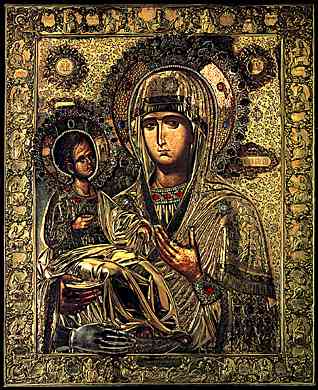 THE MIRACLE-WORKING
ICON,THE VIRGIN TROYERUCHITSA
The icon of the Virgin Troyeruchitsa (of the Three Hands) is the
most revered one in Chilandar, and the most significant icon for the Serbian people.
According to legend, it belongs to the icons painted by the Apostle and Evangelist St.
Luke, the first Christian painter. There is a painting of St. Nicholas on the reverse side
of the icon. The icon earned its name in the 8th century. It was the time of the
iconoclast fury. One of the greatest opponents to it was John Damascene, at that time
still living the secular life. Because of his writing against the iconoclasts, his right
hand was cut off. Holding the hand in his healthy one, John Damascene prayed the whole
night through before the Holy Virgin’s icon, asking her to heal his hand, so that he
could go on writing about the Holy icons veneration. And the miracle happened. Out of
gratitude, the saint had a hand done in silver, and added to the icon.
After having been miraculously healed, John Damascene entered a
monastic order. He spent his monastic life in the Lavra of St. Sava of Jerusalem. He
brought along the miracle-working icon of his Benefactor, the Virgin of the Three Hands.
There were two more relics in the Lavra: the miracle-working icon of the Virgin
Galaktotrophousa (She Who Suckles) and pateritsa, the episcopal staff of St. Sava of
Jerusalem. The legend has it that on his deathbed this saint foretold that a royal son of
the same name, Sava, would come to the monastery, and that at the moment of his paying
tribute to the tomb the tied up staff will fall to the ground. He bequeathed both
monastery relics to the future monk with the name Sava, as his blessing. John Damascene
added his own bequest, that the royal son should be presented with the icon ofthe Virgin
Troyeruchitsa.
Five centuries later the prophecy of St. Sava of Jerusalem came
true. The Serbian monk Sava arrived to Lavra. While he was paying tribute to the
saint’s tomb, the episcopal staff fell down. The miracle repeated the next day, all
doubts of the monks gone. They knew for sure then that the Serb Sava was the one they had
been waited for.
|
The miracle-working icon of
the Virgin Troyeruchitsa was cherished on the courts of all the rulers of the Nemanyich
dynasty. In the late 14th century it was transferred from the court of the Tzar Dushan the
Mighty to the monastery Studenica. In the early 15th century, Studenica became
the target of the Turkish invaders. Advised that the Turks were approaching the
monastery, the monks quickly took out all of the valuable objects. They tied the icon of
the Virgin Troyerichitsa to the pack-saddle of a donkey, and let it go wherever the Virgin
led him. The donkey passed through Serbia and Macedonia, to arrive to Mount Athos. It
stopped in the vicinity of Chilandar. Seeing the donkey and understanding what was going
on, the monks from the monastery hurried to meet it. When they took the icon off the
donkey, the animal dropped dead.
At the end of the 15th century, Chilandar had a problem regarding election of the new
abbot. Numerous monks of Serbian, Russian, Greek and Bulgarian origin could not come to a
decision. Then, during an evening service, the voice of the Holy Virgin was clearly heard
coming from the icon, saying that she was their abbess. The next morning, during the
morning service, the icon was found on the abbatial throne.
Thinking that it was a trick, the monks returned it to the altar. But the same thing
repeated the next day. The monks understood then that they should not continue with the
election or move the icon from the abbatial throne. Thus the Virgin Troyeruchitsa became
the abbess and patron of Chilandar. In the year 1905, at the request of the Headquarters
of the Russian Tzar Army, then at war with Japan, a copy of the icon Troyeruchitsa was
made and sent to the battlefield, to help the Orthodox Russian army. The Russians indeed
started to win the battles. After the peace was signed between the two empires, the copy
of the icon was returned to Chilandar.
In the 90s of the 20th century, the magnificent copy of the Virgin
Troyerchitsa arrived to Serbia. It is displayed in the Temple of St. Sava, on the Vrachar
plateau, on a special proskynetarion in the nave, next to the abbatial throne. There is an
ever-burning big sanctuary lamp in front of the icon, the oil of which has already healed
many a sick person. The icon of the Virgin Troyeruchitsa is the first Athonite relic which
has been taken out of the Holy Mountain, against the canonical rules. In 1993 it was
displayed in the church of St. Demetrios in Salonika, and was visited by more than a
million of believers. It performed another of its many miracles there, giving sight to a
33-year-old man who had been blind ever since his birth.
THE MIRACLE-WORKING ICON, THE VIRGIN NOT-BURNING-IN-FIRE
The icon of the Virgin Not-Burning-in-Fire remained, as its name suggests, untouched
in a great fire. The premises where she stood were burnt to the ground. The sooty icon was
taken out of the ashes and put into the altar area of the Chilandar katholikon, where it
still stands.
|
|
THE MIRACLE-WORKING ICON,THE VIRGIN GALAKTOTROPHOUSA
The Virgin Galaktotrophousa (She Who Suckles) is one of rare icons. It depicts the
Holy Virgin suckling the Infant Christ.
This icon originally stayed in the monastery of St. Sava Consecrated in Jerusalem.
Together with his staff it was bequeathed to the future Sava, the royal son who would come
to the monastery as a simple pilgrim. It was expected that at the moment of his paying
respect to the tomb of Sava of Jerusalem the tied up Episcopal staff would fall down. The
prophecy came true when the Serbian monk Sava arrived to the monastery in the 13th
century.
St. Sava the Serb was presented with the Episcopal staff of St. Sava of Jerusalem, the
icon of the Virgin Troyeruchitsa formerly belonging to John Damascene, and the icon of the
Virgin Galaktotrophousa.
|
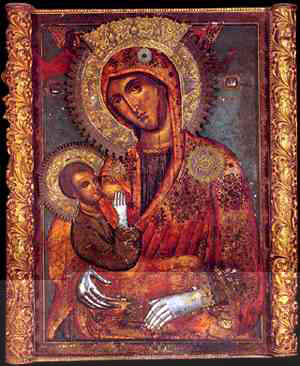 |
Upon his return to Mount Athos, Sava displayed the icon of
the Virgin Galaktotrophousa in the kellion in Karyes. On that occasion, a precedent in
Orthodoxy occurred. Namely, the icon was placed to the left of the Royal Doors, on the
place belonging to Christ.
|
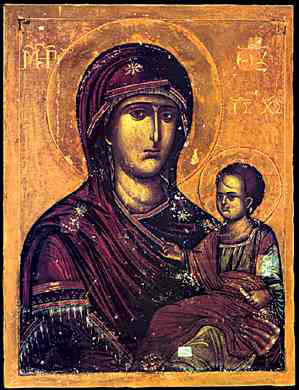 |
THE
MIRACLE-WORKING ICON, THE VIRGIN POPADIKI
The icon of the Virgin Popadiki (Popska of the Priest) is a procession icon. On its
reverse side there is a painting of the Presentation of the Holy Virgin, by one of the
best painters of the time. The same painter executed in 1360 the Great Deesis on the
iconostasis of the Chilandar church, as well as the miniatures of the Evangelists in the
Roman’s Gospel. The Virgin Popadiki was repainted in the 16th or 17th
centuries, while the Presentation of the Virgin has retained its original form.
|
|
THE
MIRACLE-WORKING ICON, THE VIRGIN AKATHIST
The icon of the Virgin Akathist is displayed on the altar screen of the Chilandar
katholikon. Around the icon are painted small scenes illustrating the whole Akathistos
Hymn, the hymn to the Virgin Mary.
|
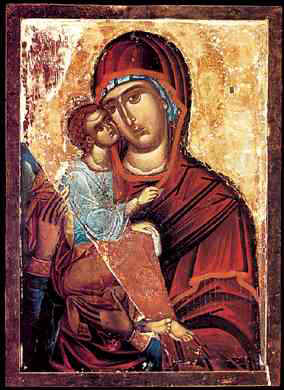
|
|
THE
MIRACLE-WORKING ICON, THE VIRGIN ECCLESEIARCHOU
The icon of the Virgin Eccleseiarchou (of the Sacristan) was named after the sacristan
(eccleseiarchon) whom she had taught a lesson. According to legend, this sacristan was
somewhat negligent. He was supposed to see to it that the sanctuary lamp continuously
burns in front of the Holy Virgin’s icon. Its flame often went out because of the
draught. Once when he was lighting it up, unsuitable words slipped off the
sacristan’s lips. He was struck dumb at that very moment, and the power of speech was
returned to him only after his many prayers and tears. Legend has it that he became the
most zealous servant of the Temple of God.
|
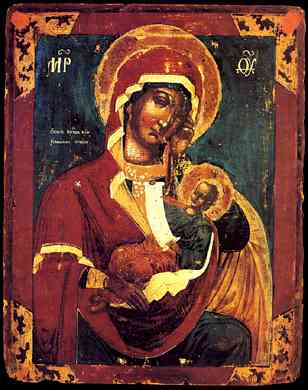 |
|
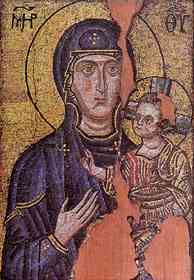 |
THE
MIRACLE-WORKING ICON, THE VIRGIN HODEGETRIA
The icon of the Virgin Hodegetria (The Virgin of Guidance) is a mosaic icon. It
belonged to the first Serbian saint, Symeon Nemanya. On his deathbed he asked his son,
monk Sava, to bring the icon to him, and he was singing psalms before it until he expired.
Today the icon is displayed in the central part of the treasury of the new Chilandar
library. It is in front of this icon that monks pray and ask forgiveness for every action
that is being carried out in this part of the monastery. In 1996 a copy of the Virgin
Hodegetria was made for the needs of the Historical Museum of Serbia.
|
|
BIG MIRACLES OF MOUNT ATHOS AND THE
MONASTERY OF CHILANDAR
According to Athonite monastic tradition, the End of Time will come when the three
miracles of the Holy Mountain vanish: the miracle-working icon of the Virgin Portaotissa
from Iveron, the Vine of St Symeon Nemanya and the Well of St Sava the Serb, both
belonging to Chilandar.
|
The miracle-working icons are
specially revered on the Holy Mountain. Regarding the number of miracle-working
icons. Chilandar ranks the first in the Christian world. Each icon depicts the
patron of Chilandar and Mount Athos, the Holy Virgin.
|
|

|
|
 
|
